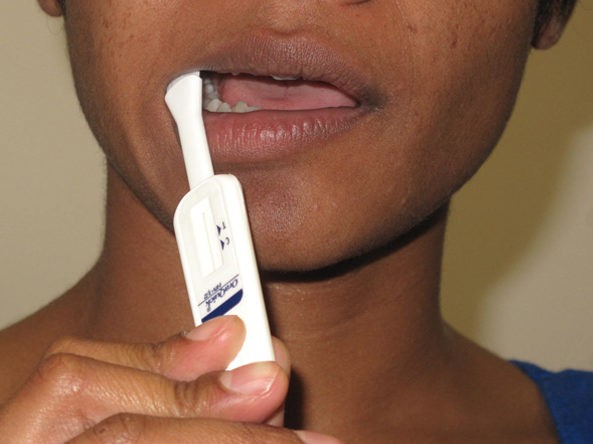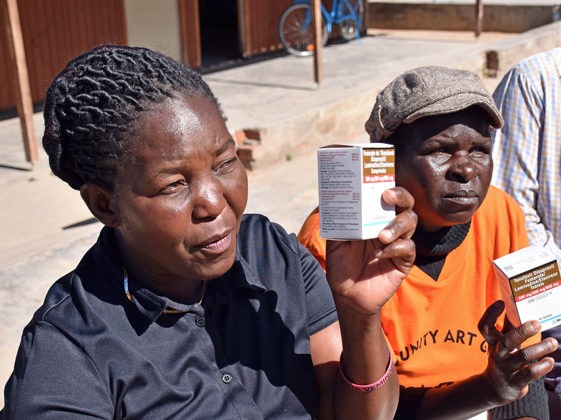Article and Study Summary:
Single-dose Liposomal Amphotericin B Treatment for Cryptococcal Meningitis
Published in:
New England Journal of Medicine 2022;386(12):1109-1120
https://www.nejm.org/doi/full/10.1056/NEJMoa2111904
Authors:
Jarvis JN, Lawrence DS, Meya DB, et al.
Summary:
The Ambition trial was an open-label, phase 3, randomized controlled non-inferiority trial that compared an induction regimen with a single high dose of liposomal amphotericin B, against the regimen recommended by the Word Health Organization for the treatment of cryptococcal meningitis in people living with HIV. Adults living with HIV in five African countries with a first episode of cryptococcal meningitis were recruited to participate and randomized (1:1) to receive either the experimental induction regimen or the WHO standard of care. The experimental regimen included a single high dose of liposomal amphotericin B plus 14 days of oral flucytosine and fluconazole, and the control regimen included amphotericin B deoxycholate plus flucytosine for 7 days, followed by high dose fluconazole for another 7 days. The primary end point was death from any cause at 10 weeks after randomization. The experimental regimen was found to be non-inferior to the standard of care and had a better safety profile. These results suggest a regimen that includes a single high dose of liposomal amphotericin B is a promising treatment of HIV-associated cryptococcal meningitis in resource- limited settings.
Discussion Questions:
1) How could the findings in this study impact policy where you work?
2) What would it take to implement the regimen from this study in the programs you work with? Do you have any experiences to share?
Please share your thoughts and experiences with us in the comments section below.
Full Synopsis:
PDF version available in English, French, and Portuguese.
Study Summary
The Ambition trial was an open-label, phase 3, randomized, controlled non-inferiority trial that compared a single high dose of liposomal amphotericin B, given with oral flucytosine and fluconazole for 2 weeks, against the first-line induction regimen recommended by the Word Health Organization (WHO) for the treatment of cryptococcal meningitis in people living with HIV (PLHIV).
Study Setting
- Eight hospitals in Botswana (1), Malawi (2), South Africa (2), Uganda (2) and Zimbabwe (1)
Methods
- PLHIV (≥18 years of age) with a first episode of cryptococcal meningitis, diagnosed by a positive India ink stain or cryptococcal antigen test of a cerebrospinal fluid (CSF) sample, were recruited to participate.
- Participants were excluded if they had received more than two doses of amphotericin (any dose) or fluconazole (dose of ≥800 mg) before screening; were pregnant or breastfeeding; were taking contraindicated concomitant drugs; or had any previous adverse reactions to a trial drug.
- Late exclusion criteria based on baseline blood tests were an alanine aminotransferase >5 times the upper limit of the normal range, a polymorphonuclear leukocyte count <500/mm3 or a platelet count <50,000/mm3.
- Participants were randomized (1:1) to receive either the experimental regimen or the WHO-recommended regimen (control group).
- The experimental regimen included a single dose of liposomal amphotericin B (10 mg/kg, in 1L of 5% dextrose, administered over 2 hours) plus 14 days of oral flucytosine (100 mg/kg/day) and fluconazole (1200 mg/day).
- The current WHO-recommended regimen included amphotericin B deoxycholate (1 mg/kg/day, in 1L of 5% dextrose, administered over 4 hours) plus oral flucytosine (100 mg/kg/day) for 7 days, followed by oral fluconazole (1200 mg/day) on days 8 through 14.
- All the participants were treated in-hospital for a minimum of 7 days and received 1L of intravenous normal saline before any amphotericin dose, plus at least 1L of additional intravenous fluid on each day of amphotericin therapy. Potassium and magnesium supplements were given on each day the participants received amphotericin and then for two additional days.
- Laboratory blood tests were monitored regularly during the first 2 weeks and again at week 4. Lumbar punctures for quantitative cryptococcal cultures were performed at the time of diagnosis and on days 7 and 14. Participants with increased intracranial pressure received additional daily therapeutic lumbar punctures until the pressure was controlled at <20 cm of water.
- After the 2-week induction period, all participants received fluconazole 800 mg per day for 8 weeks and then 200 mg per day thereafter.
- Participants were followed at outpatient clinics for 10 weeks and were contacted by telephone at week 16. If a participant missed a clinic appointment, follow-up was performed by the trial teams either by telephone or in person.
- Antiretroviral therapy was initiated, reinitiated, or switched during weeks 4 to 6, chosen in accordance with national guidelines.
- The primary end point was death from any cause at 10 weeks after randomization.
- Secondary end points included death from any cause at 2 weeks, 4 weeks, and 16 weeks; the rate of fungal clearance from CSF per day during induction therapy; adverse events of grade 3 or 4; and change from baseline in laboratory values.
- The specified non-inferiority margin was 10% for the upper boundary of the one-sided 95% confidence interval (CI) and the primary analysis was performed in the intention-to-treat population, which included all the participants who had undergone randomization and had not met any late-exclusion criteria.
- Sensitivity analyses included: 1) a per-protocol analysis, excluding participants who missed >1 day of any single treatment in the first 2 weeks or missed >2 weeks of fluconazole consolidation treatment between weeks 2 and 10; and 2) an analysis adjusted for the pre-specified covariates of trial site, age, sex, baseline Glasgow Coma Scale score, CD4+ cell count, cryptococcal colony forming units (CFU)/ml of CSF, antiretroviral therapy status, hemoglobin level, and CSF opening pressure.
Study Population and Follow-up
- From January 2018 to February 2021, 844 participants underwent randomization, of which 30 were excluded, leaving 814 participants (407 in each group) in the intention-to-treat population.
- No participants were lost to follow up and the baseline characteristics of participants were similar in the trial groups.
- An additional 30 participants were excluded from the per-protocol population.
Primary Outcome
- In the intention-to-treat analysis, 10-week mortality was 24.8% (95% CI, 20.7 to 29.3) in the liposomal amphotericin B group and 28.7% (95% CI, 24.4 to 33.4) in the control group.
- The absolute difference in mortality at 10 weeks between the liposomal amphotericin B group and control group was −3.9%, and the upper boundary of the one-sided 95% CI was 1.2%, which was within the pre-specified non-inferiority margin (p<0.001 for non-inferiority).
- Results of the per-protocol and pre-specified adjusted analyses were consistent with those of the primary end-point analysis.
- In pre-specified superiority analyses comparing the liposomal amphotericin B group to the control group, the between-group difference in 10-week mortality was −3.9% (95% CI, −10.0 to 2.2) in the unadjusted analysis, and −5.7% (95% CI, −11.4 to −0.04) in the analysis adjusted for the covariates associated with cryptococcal mortality.
Secondary Outcomes
- Mortality at 2, 4 and 16 weeks were consistent with the primary end-point results, and within the non-inferiority margin.
- The mean rate of fungal clearance from the CSF over the course of 14 days was −0.40 log10 CFU/ml/day in the liposomal amphotericin B group and −0.42 log10 CFU/ml/day in the control group, for a difference of 0.017 log10 CFU/ml/day (95% CI, −0.001 to 0.036).
- During the initial 21 days of treatment, there were 382 grade 3 or 4 adverse events in 210 of 420 participants (50.0%) in the liposomal amphotericin B group and 579 grade 3 or 4 adverse events in 263 of 422 participants (62.3%) in the control group (p<0.001).
- Compared to the control group, a lower percentage of participants in the liposomal amphotericin B group experienced life-threatening (grade 4) adverse events (21.7% vs. 30.1%; p=0.005); had grade 3 or 4 anemia (13.3% vs. 39.1%; p<0.001); required blood transfusions (7.6% vs. 18.0%; p<0.001); and had thrombophlebitis requiring antibiotic therapy (1.9% vs. 6.6%; p=0.001). Mean rise in serum creatinine levels from baseline to day 7 was also lower in the liposomal amphotericin B group (20.2% vs. 49.7% increase; p<0.001).
Critical Analysis
The open-label, phase 3, randomized, controlled non-inferiority Ambition trial showed that induction therapy for HIV-associated cryptococcal meningitis with a single 10 mg-per-kilogram dose of liposomal amphotericin B, in combination with oral flucytosine and fluconazole was non-inferior to the WHO-recommended standard of care that included 1 week of amphotericin B deoxycholate given with flucytosine. The liposomal amphotericin B regimen was also associated with significantly fewer adverse events.
The following points should be considered when interpreting the study findings:
- This trial was open label, and clinical care of critically ill participants with advanced HIV disease is complex. However, both the primary end point and the key safety end points were objectively measured, and a consistent approach to HIV management was agreed on by the investigators beforehand and applied throughout the trial to avoid differential management strategies or outcome assessments in the groups.
- While liposomal amphotericin B did not meet the criterion for superiority in an unadjusted analysis of 10-week mortality, it did demonstrate superiority in an analysis adjusting for covariates associated with cryptococcal mortality.
- Participants benefitted from pre-emptive fluid and electrolytes to reduce the risk of amphotericin B–related toxic effects, an intensive blood-monitoring schedule, and active management of adverse events. This may limit the generalizability of safety findings from this trial in resource-limited settings where such measures are not available.
- An additional potential benefit of the liposomal amphotericin B regimen is that it may be possible to shorten the length of hospital stay needed to administer effective treatment. The trial protocol required that all participants remain hospitalized for a 7-day period of inpatient monitoring. However, when scaled-up in real-world settings, earlier discharge will probably be possible for some patients.
Implications
The open-label, phase 3, randomized, controlled non-inferiority Ambition trial found that an induction regimen that includes a single high dose of liposomal amphotericin B was non-inferior to the current WHO-recommended regimen for treatment of HIV-associated cryptococcal meningitis. The trial regimen had fewer drug-related adverse effects and is easier to administer than current standard of care, which makes it a promising treatment in resource-limited settings. However, improved access to liposomal amphotericin B and flucytosine will be required in order to translate these findings to programmatic settings.
This article synopsis was written by Dr. Cassia Wells. Share your thoughts on this article or suggest an article for Journal Club by emailing her at caw2208@columbia.edu.
Articles of Note:
BNT162b2 Protection against the Omicron Variant in Children and Adolescents









